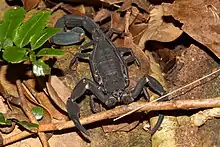Tityus pachyurus
Tityus pachyurus is a species of arachnid edemic to Latin America.
| Tityus pachyurus | |
|---|---|
 | |
| Scientific classification | |
| Kingdom: | Animalia |
| Phylum: | Arthropoda |
| Subphylum: | Chelicerata |
| Class: | Arachnida |
| Order: | Scorpiones |
| Family: | Buthidae |
| Genus: | Tityus |
| Species: | T. T. pachyurus |
| Binomial name | |
| Tityus T. pachyurus Pocock, 1897 | |
Characteristics
Tityus pachyurus can grow from 6 to 9 cm in length, its pedipalps are reddish, while the fourth and fifth segments of the post-abdomen are dark and thicker, feeding is based on larvae of beetles (tenebrians) and cockroaches.[1] this species occurs in Central America (Costa Rica and Panama) and in South America (Colombia), in Colombia this species occurs in the departments of Antioquia and Chocó. It is found mainly in tropical forests, urban regions and places with high tourist and industrial activity. like many scorpions, it's nocturnal.[2]
Medical significance
It is the species responsible for the most serious accidents involving scorpions in Central America and Colombia, including children. In Colombia, we report a case of a 12-year-old boy, stung in the thigh, the victim had a lot of pain at the site, and the case quickly progressed to systemic effects, with myocardial dysfunction, cardiovascular collapse, cardiac arrest and pulmonary edema.[3] This species has a median lethal dose of 4.8 mg / kg.[1]
References
- Barona, Jacqueline; Otero, Rafael; Núñez, Vitelbina (March 2004). "Toxicological and immunological aspects of scorpion venom (Tytius pachyurus): neutralizing capacity of antivenoms produced in Latin America". Biomédica. 24 (1): 42–49. doi:10.7705/biomedica.v24i1.1247. PMID 15239600.
- Borges, A.; Miranda, R. J.; Pascale, J. M. (2012). "Scorpionism in Central America, with special reference to the case of Panama". Journal of Venomous Animals and Toxins Including Tropical Diseases. 18 (2): 130–143. doi:10.1590/S1678-91992012000200002.
- Izquierdo, Ledys María; Rodríguez Buitrago, Javier R. (15 September 2012). "Cardiovascular dysfunction and pulmonary edema secondary to severe envenoming by Tityus pachyurus sting. Case report". Toxicon. 60 (4): 603–606. doi:10.1016/j.toxicon.2012.05.021. PMID 22683677.